came on the scene in 2006. The 2006 Ford Fusion shares a design platform with the Mercury Milan and the Lincoln Zephyr. In 2007, the Zephyr is replaced by the Lincoln MKZ. 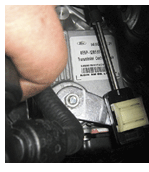 The Fusion comes with a choice of 4-cyl. and 6-cyl. powerplants. The four cylinder is a 2.3L 16-valve DOHC engine. It uses a 9.7:1 compression ratio and produces 160 hp at 6,500 rpm and 150 ft.lbs. of torque at 4,000 rpm. The head and block are both aluminum. It is a coil-on-plug ignition and uses electronic throttle control.
The Fusion comes with a choice of 4-cyl. and 6-cyl. powerplants. The four cylinder is a 2.3L 16-valve DOHC engine. It uses a 9.7:1 compression ratio and produces 160 hp at 6,500 rpm and 150 ft.lbs. of torque at 4,000 rpm. The head and block are both aluminum. It is a coil-on-plug ignition and uses electronic throttle control.
It is PZEV certified and has a 150,000 mile recommended tune-up. In 2006, the V6 choice is limited to a 3.0L 24-valve DOHC engine. This engine uses a 10:1 ratio and also built for 87 octane. It produces 221 hp at 6,250 rpm and 205 ft.lbs of torque at 4,800 rpm. When the Zephyr’s sales were in the toilet, Ford flushed it and replaced it with the MKZ.
The MKZ sports a 3.5L 24 DOHC engine using a timing-chain-driven water pump. This engine uses a 10.3:1 compression ratio and still uses 87 octane fuel. The 3.5L engine produces 263 hp at 5,950 rpm and 249 ft.lbs. of torque at 4,500 rpm. All three engines feature chain-driven cams and intake phase shifting (IPS) cam timing that can vary up to 29 degrees.
With IPS on a Ford, as duty cycle command from the PCM increases, the cam timing retards. This concept is backwards from that of what you’d find on a Ford vehicle, like a 5.4L, that uses DEPS (Dual Equal Phase Shifting). Unlike EPS (Exhaust Phase Shifting) found on the 2.0L DOHC Focus/Contour/Escort engine, DEPS and IPS will still use an EGR valve.
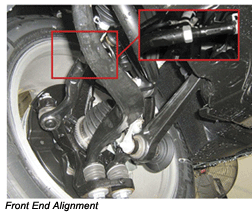 Transmission Service
Transmission Service
The transmission choices in the Fusion/Milan/ Zephyr/MKZ are the G5M 5-speed manual and FNR5 5-speed auto for the 2.3L versions. The manual transmission has no fluid surprises. It uses 75w90 gear oil.
However, the 5-speed automatic does have a surprise. It doesn’t use Mercon V. The fluid requirement of the 5-speed auto is Mazda V trans fluid. Do not confuse Mazda V fluid for Mercon V, it is not the same thing. The Motorcraft part number for Mazda V fluid is XT-9-QMM5. The 3.0L and the 3.5L have Aisin 6 speed automatics. The 6-speed auto also contains a fluid requirement surprise of its own. It does not use Mercon V or Mazda V. It simply uses a Mercron/Dextron equivilent.
Also, when looking at the side of a 6-speed trans in a Fusion/Milan/Zephyr/MKZ, you’ll notice that there are quite a few wires going into the transmission range sensor. That is because it is not just a range sensor, it is also the transmission control module.
So if you get one of these with a faulty range sensor, you won’t be able to replace it unless your shop can program modules.
Front End Alignment
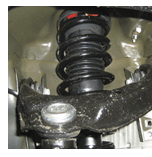 Front toe is adjusted in the usual manner at the tie rods.
Front toe is adjusted in the usual manner at the tie rods.
To adjust front camber, you will have to replace the upper control arms with bushings that are set to a choice of either +.4 degrees or -4 degrees.
Rear Rear Alignment
Rear toe is adjusted without any special tools or parts replacement.
Rear camber adjustment is made without special tools or parts replacement.
Parking Brake Adjustment
To adjust the parking brake, you will have to remove the back cover of the center console and place a 10mm socket on the adjuster nut.
With the vehicle raised on a lift and in neutral, the wheels should drag at two clicks of the handle, and completely lock at five clicks.
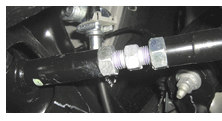 AWD Service
AWD Service
On all-wheel-drive models, the Power Transfer Unit (PTU) does not fill all the way to the filler hole like a typical transfer case would. Instead, the fill mark is 1-1/2 inches below the fill hole. To check the level, you must fabricate a dipstick from a plastic tie strap. Mark the tie strap 1-1/2 inches from the tapered end with a marker, then again a 1-1/2 inches from the end. Bend the tie strap into right angle so that the tip points down when inside the fill hole. Lower the strap in until the upper mark is at the bottom edge of the filler hole. Remove and see where the strap is wet at. It should be at the first 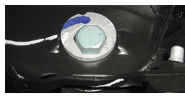 line.
line.
If it is low with no external signs of leakage, then the left internal axle seal is probably leaking. There is a cavity inside the case between the inner and outer axle seal that can fill with fluid. If the PTU is over filled, then it will push fluid out of the vent at the top when driving. There is no drain plug on the PTU so draining an over-filled PTU will be difficult. The PTU requires 75w140 synthetic gear oil.
The Rear Drive Unit (RDU) of an AWD Fusion is similar to the RDU of an AWD Escape except that they have different gear ratios. So even though they might appear outwardly that they will interchange, they will not.
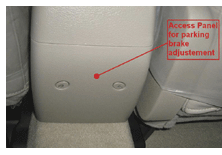 EGR and MAP Sensors
EGR and MAP Sensors
Both, the 4 cyl and V6, use a stepper motor EGR valve.
The MAP sensor on these vehicles is used to infer EGR flow, not fuel control.
Oil Change Guide
All of these engines use 5w20 engine oil. The 2.3L has a serviceable filter for the VCT solenoid. The filter is accessed from under the valve cover. At the intake cam thrust cap is a plug with an allen socket head. Remove the plug and the filter is under it. The base part number on the filter is 6C683. There is no specified mileage for replacement.
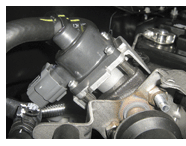 These engines also use electrically heated PCV valves. The heater in the valve is to prevent icing in the PCV and on the back of the throttle plate. The PCV heater circuits are monitored by the PCM and will set an MIL illuminating code if there is a circuit -related fault present.
These engines also use electrically heated PCV valves. The heater in the valve is to prevent icing in the PCV and on the back of the throttle plate. The PCV heater circuits are monitored by the PCM and will set an MIL illuminating code if there is a circuit -related fault present.
Belts
There is no adjustable power steering tensioner on the 3.5L. The 3.5L uses what is called a “stretch belt.” This belt is slightly elastic by design. It is removed and installed by rolling it off and rolling it on. This belt can not tolerate lubricants. Do not spray these belts with any lubricant or dressing. If something leaks onto this belt, it must be replaced. FoMoCo has tools 303-1252/2 to aid installation and 303-1252/1 to aid in removal.
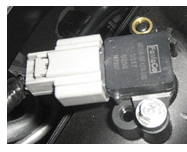 The V6 uses a cam driven water pump at the rear of the left cylinder head.
The V6 uses a cam driven water pump at the rear of the left cylinder head.
Marker Lights Trick
Located in the forward side of the front inner fender is an access panel to replace the marker light bulbs through.
AC Service
A couple of things to note when servicing the A/C system on these vehicles have to do with the condenser. The top two rows in the condenser are the power steering cooler.
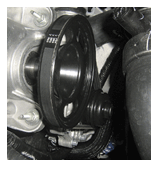 This similar idea is also used in the newer Escapes, however, in the Escape these upper rows are the transmission cooler. The condenser on the Fusion also houses an integrated receiver/drier. The drier is a molded housing down one side of the condenser. Inside of the drier housing is a serviceable descant filter. To replace the descant filter, remove the snap ring at the top of the assembly, remove the aluminum plug and slide the filter out.
This similar idea is also used in the newer Escapes, however, in the Escape these upper rows are the transmission cooler. The condenser on the Fusion also houses an integrated receiver/drier. The drier is a molded housing down one side of the condenser. Inside of the drier housing is a serviceable descant filter. To replace the descant filter, remove the snap ring at the top of the assembly, remove the aluminum plug and slide the filter out.
These vehicles are optional with heated and cooled seats. The seat cooling is achieved by use of a Thermal Electric Devise (TED). This is not just simply piping A/C vent air into the seats. Instead, a TED is a 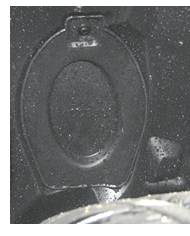 series of semi-conductors that can absorb and transfer heat. Inside the seat is a fan, tubing and a TED. The TED has a filter under the seat that is to be replaced every 3 years/36,000 miles.
series of semi-conductors that can absorb and transfer heat. Inside the seat is a fan, tubing and a TED. The TED has a filter under the seat that is to be replaced every 3 years/36,000 miles.
To replace the seat filter, run the seat all the way back, push up on the plastic out ring of the filter and rotate until it unlocks. Reverse to install.
The radio is a programmable module. If it is replaced for a new one, the new one will have to be programmed with a scan tool or the back lighting will not work.
No Fuel Filter
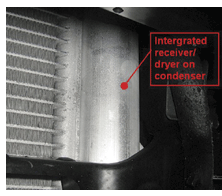 There is no serviceable fuel filter on these vehicles. The fuel filter is built-in to the fuel pump. But at least they gave us a trap door under the rear seat to access the fuel pump for replacement.
There is no serviceable fuel filter on these vehicles. The fuel filter is built-in to the fuel pump. But at least they gave us a trap door under the rear seat to access the fuel pump for replacement.

